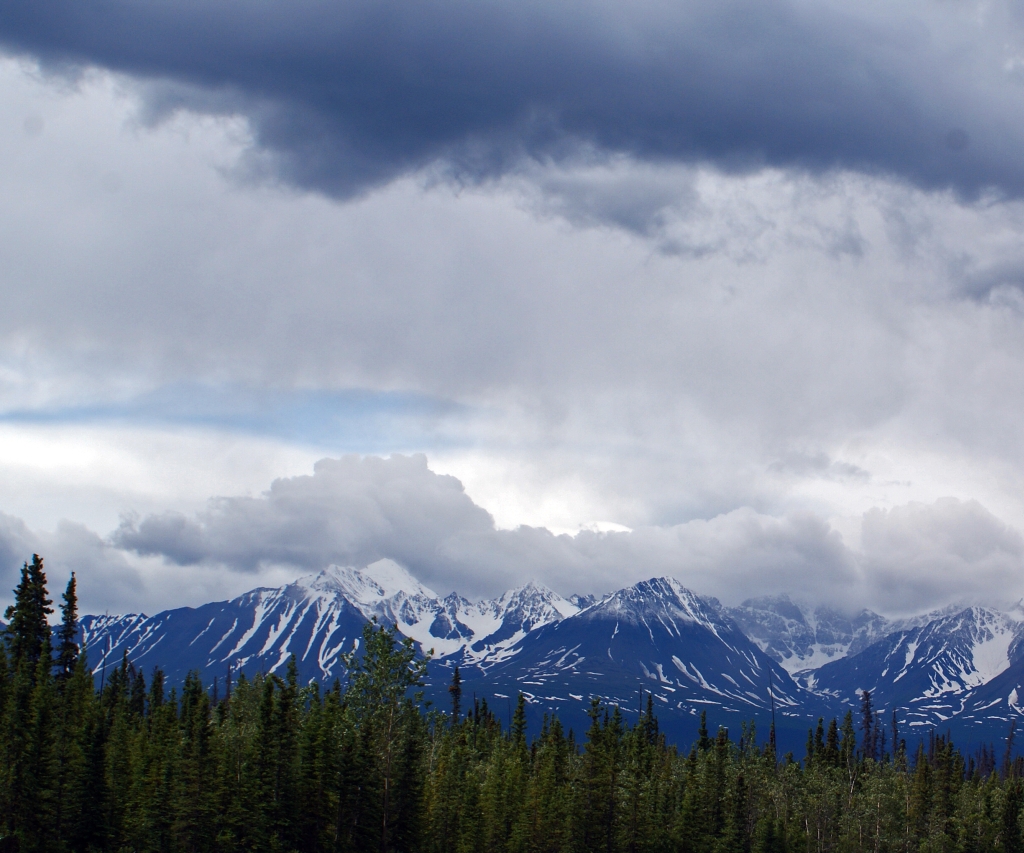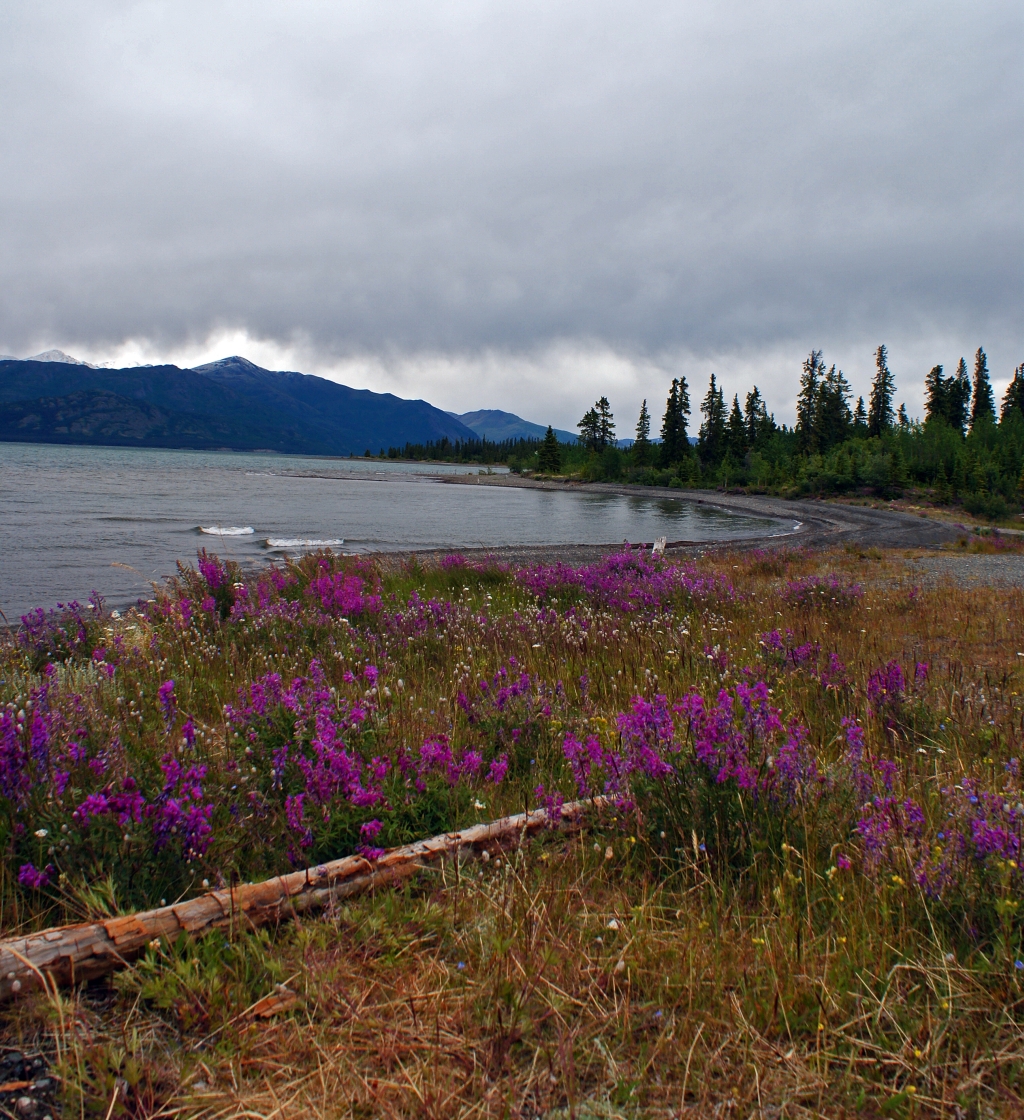 |
| A hazy day due to the forest fires in the lower 48. This picture was taken at a rest area on the Yellowhead Hwy between Houston and Telkwa. |
As I described in
The Yellowhead Hwy (Hwy 16): Jasper to Burns Lake I woke early and so afterwards started driving west toward the Stewart-Cassiar Hwy. The sky was filled with haze it greatly reduced the visibly. While listening to the BBC they mention that the haze was due to the large forest fires in the Western United States. I found it interesting that the haze traveled west when most weather fronts travel west to east and I thought the mountain would have kept the smoky haze to the east but I was wrong. The traffic was very light along the Yellowhead this early in the morning and the wildlife does make use of the highway at that time. I saw three foxes hunting along the shoulder and one moose was travel west on it. I was not able to stop and take pictures if I tried they would have been long gone.
 |
| The Buckley River formed Moricetown Canyon. The community fishes salmon during the run off the boulder. |
I stopped at a First Nation community called
Moricetown. There is a rest area just before the town where you can see and take some photos of Moricetown Canyon. The residences of Moricetown fish for salmon in the rapids of Bulkley River. The salmon were not running while I was visiting but I did get some picturesque views of the canyon.
 |
| Moricetown Canyon from the bridge in the picture above. |
 |
| Lance-leaf or Spreading Stonecrop. If you know what it is let me know. |
After exploring the canyon I turned my car west toward
New Hazelton.
New Hazelton
has a nice Visitor Centre where I could finely get cleaned up and change out of the clothes I spend last night in. I wish I had more time to explore the town they have the
'Ksan Museum and Historical Village which I believe would make an interesting visit. While I was cleaning up, people were arriving and setting up a farmer's markets in the New Hazelton parking lot but did not have the time to waiting for them to open so I toured the displays inside their Visitor Centre before hitting the road.
 |
Cow Parsnips, they perfumed the air
all around the intersection. |
There is 27 miles between New Hazelton and the Stewart-Cassiar Highway (Hwy 37). I stop at a gas station just before the junction to fill up before starting up the highway. There are long stretches along this road where there is no gas or other automobile services. At 10:30 I started my journey up the Stewart-Cassiar Hwy. I soon passed a road which leads to the village of
Kitwanga. If you are interested Kitwanga, it has a nice collection of Totem Pole to view. I kept going north and but stop at Gianyow road to the village. The whole area was blooming with Cow Parsnip and the scent from the flowers just filled the air around them. I do not remember ever walking in a field of wildflowers and having the scent perfume the air without leaning toward a flower to smell it. I initially stopped at the cross road to take pictures of the mountains with the flowers but the scent of the flowers is what I remember.
 |
Gitanyow North Intersection: The meadow with the
Sheeka Mountains in the background |
 |
| Nass River Bridge Rest Area |
I made a few more stopped before reaching the junction to the
Stewart, BC and Hyder, AK. The road is known as the Stewart Highway (Hwy 37A). The road winds it way down through the mountains to Stewart and of coarse I had to take pictures along the way. The most interesting stop was
Bear Glacier Provincial Park. I left after a walk along the highway try to find the best angle to photography the glacier.
+Hwy.jpg) |
| A second hanging Glacier heading down to Stewart, BC. |
 |
Hanging Glacier Along Stewart Hwy. I have also
seen the road refer to as Glacier Hwy. |
 |
| Bear Glacier viewed from the east side of the park. |
 |
| Bear Glacier Mouth: I hope I am using the correct description. |
 |
| Bear Glacier from the west side. |
Stewart was my next stop, it was mid afternoon by the time I reached the town and I needed to eat lunch. After lunch I explored the Visitor Centre, walked their boardwalk along the marsh, checked out the shops and explored the local museum's outside exhibits. I want to visit Hyder, AK and Salmon Glacier but the sign post stated 50 as a distance. The 50 was most likely in kilometers but being American I thought it was 50 miles. It was very late in the afternoon to go that far and so I started back up the highway.
 |
| The view from Stewart's Boardwalk. |
 |
| The Ripley Creek Inn from the boardwalk |
 |
| I found a great t-shirt here. |
 |
| Another old building on Main Street. |
 |
| Rainey's Cabin located at Stewart's Museum. |
 |
| Sign on Rainey's Cabin |
 |
| Stewart's Museum |
 |
Bitter Creek Bridge was washout in September 2011.
Stranding everyone in town for 3 weeks. The government
sent a boat to ferry the tourist out of town. |
 |
| A waterfall on the way back up the Stewart Hwy. |
 |
| Fireweed found on the Stewart Hwy. |
 |
| Stewart Hwy (37A): Daisy |
 |
| Stewart Hwy (37A): Goatsbeard |
I left Stewart Highway and turned north hoping to find a place to slay the night. Mehan Lake Rest Area was my last stopped before I called it a night at
Bell II. Bell II is a privately run lodge where you can gas up, get a nice meal and lay your head down for the night. By the time I reach here I was dead tired and I knew if I went any farther I be in trouble. I asked while gassing up the car if they had any tent site since all I could see there RV sites. Yes, they did about 4-5 tent sites. The tent sites here nice but the mosquitoes were viscous this was the first place I had any trouble with bugs. Once the tent was up I went up to the lodge for dinner and then found the recreation area to hide from the bugs until it was time to turn in for the night.
 |
| Mehan Lake Rest Area |
 |
| Close up of the Mountains at Mehan Lake Rest Area |
 |
| Finally I am including a picture of me, a father and two grow sons asked me to take a picture of them and they offer to take my picture. You can see the picnic area at the rest stop. |
























































+Hwy.jpg)


















